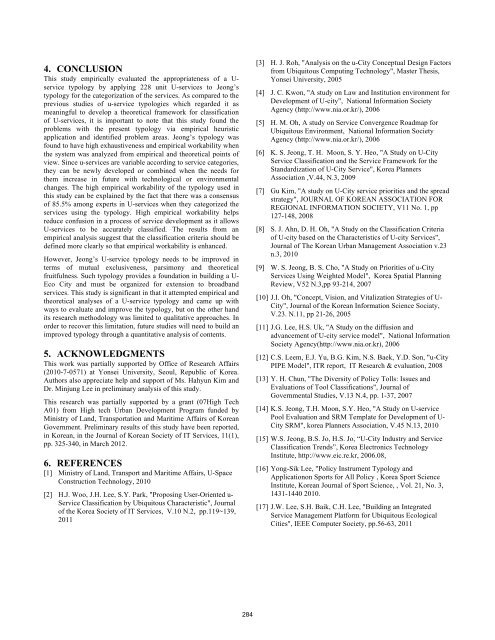icegov2012 proceedings
icegov2012 proceedings
icegov2012 proceedings
Create successful ePaper yourself
Turn your PDF publications into a flip-book with our unique Google optimized e-Paper software.
4. CONCLUSION<br />
This study empirically evaluated the appropriateness of a Uservice<br />
typology by applying 228 unit U-services to Jeong’s<br />
typology for the categorization of the services. As compared to the<br />
previous studies of u-service typologies which regarded it as<br />
meaningful to develop a theoretical framework for classification<br />
of U-services, it is important to note that this study found the<br />
problems with the present typology via empirical heuristic<br />
application and identified problem areas. Jeong’s typology was<br />
found to have high exhaustiveness and empirical workability when<br />
the system was analyzed from empirical and theoretical points of<br />
view. Since u-services are variable according to service categories,<br />
they can be newly developed or combined when the needs for<br />
them increase in future with technological or environmental<br />
changes. The high empirical workability of the typology used in<br />
this study can be explained by the fact that there was a consensus<br />
of 85.5% among experts in U-services when they categorized the<br />
services using the typology. High empirical workability helps<br />
reduce confusion in a process of service development as it allows<br />
U-services to be accurately classified. The results from an<br />
empirical analysis suggest that the classification criteria should be<br />
defined more clearly so that empirical workability is enhanced.<br />
However, Jeong’s U-service typology needs to be improved in<br />
terms of mutual exclusiveness, parsimony and theoretical<br />
fruitfulness. Such typology provides a foundation in building a U-<br />
Eco City and must be organized for extension to broadband<br />
services. This study is significant in that it attempted empirical and<br />
theoretical analyses of a U-service typology and came up with<br />
ways to evaluate and improve the typology, but on the other hand<br />
its research methodology was limited to qualitative approaches. In<br />
order to recover this limitation, future studies will need to build an<br />
improved typology through a quantitative analysis of contents.<br />
5. ACKNOWLEDGMENTS<br />
This work was partially supported by Office of Research Affairs<br />
(2010-7-0571) at Yonsei University, Seoul, Republic of Korea.<br />
Authors also appreciate help and support of Ms. Hahyun Kim and<br />
Dr. Minjung Lee in preliminary analysis of this study.<br />
This research was partially supported by a grant (07High Tech<br />
A01) from High tech Urban Development Program funded by<br />
Ministry of Land, Transportation and Maritime Affairs of Korean<br />
Government. Preliminary results of this study have been reported,<br />
in Korean, in the Journal of Korean Society of IT Services, 11(1),<br />
pp. 325-340, in March 2012.<br />
6. REFERENCES<br />
[1] Ministry of Land, Transport and Maritime Affairs, U-Space<br />
Construction Technology, 2010<br />
[2] H.J. Woo, J.H. Lee, S.Y. Park, "Proposing User-Oriented u-<br />
Service Classification by Ubiquitous Characteristic", Journal<br />
of the Korea Society of IT Services, V.10 N.2, pp.119~139,<br />
2011<br />
284<br />
[3] H. J. Roh, "Analysis on the u-City Conceptual Design Factors<br />
from Ubiquitous Computing Technology", Master Thesis,<br />
Yonsei University, 2005<br />
[4] J. C. Kwon, "A study on Law and Institution environment for<br />
Development of U-city", National Information Society<br />
Agency (http://www.nia.or.kr/), 2006<br />
[5] H. M. Oh, A study on Service Convergence Roadmap for<br />
Ubiquitous Environment, National Information Society<br />
Agency (http://www.nia.or.kr/), 2006<br />
[6] K. S. Jeong, T. H. Moon, S. Y. Heo, "A Study on U-City<br />
Service Classification and the Service Framework for the<br />
Standardization of U-City Service", Korea Planners<br />
Association ,V.44, N.3, 2009<br />
[7] Gu Kim, "A study on U-City service priorities and the spread<br />
strategy", JOURNAL OF KOREAN ASSOCIATION FOR<br />
REGIONAL INFORMATION SOCIETY, V11 No. 1, pp<br />
127-148, 2008<br />
[8] S. J. Ahn, D. H. Oh, "A Study on the Classification Criteria<br />
of U-city based on the Characteristics of U-city Services",<br />
Journal of The Korean Urban Management Association v.23<br />
n.3, 2010<br />
[9] W. S. Jeong, B. S. Cho, "A Study on Priorities of u-City<br />
Services Using Weighted Model", Korea Spatial Planning<br />
Review, V52 N.3,pp 93-214, 2007<br />
[10] J.I. Oh, "Concept, Vision, and Vitalization Strategies of U-<br />
City", Journal of the Korean Information Science Sociaty,<br />
V.23. N.11, pp 21-26, 2005<br />
[11] J.G. Lee, H.S. Uk, "A Study on the diffusion and<br />
advancement of U-city service model", National Information<br />
Society Agency(http://www.nia.or.kr), 2006<br />
[12] C.S. Leem, E.J. Yu, B.G. Kim, N.S. Baek, Y.D. Son, "u-City<br />
PIPE Model", ITR report, IT Research & evaluation, 2008<br />
[13] Y. H. Chun, "The Diversity of Policy Tolls: Issues and<br />
Evaluations of Tool Classifications", Journal of<br />
Governmental Studies, V.13 N.4, pp. 1-37, 2007<br />
[14] K.S. Jeong, T.H. Moon, S.Y. Heo, "A Study on U-service<br />
Pool Evaluation and SRM Template for Development of U-<br />
City SRM", korea Planners Association, V.45 N.13, 2010<br />
[15] W.S. Jeong, B.S. Jo, H.S. Jo, “U-City Industry and Service<br />
Classification Trends”, Korea Electronics Technology<br />
Institute, http://www.eic.re.kr, 2006.08,<br />
[16] Yong-Sik Lee, "Policy Instrument Typology and<br />
Applicationon Sports for All Policy , Korea Sport Science<br />
Institute, Korean Journal of Sport Science, , Vol. 21, No. 3,<br />
1431-1440 2010.<br />
[17] J.W. Lee, S.H. Baik, C.H. Lee, "Building an Integrated<br />
Service Management Platform for Ubiquitous Ecological<br />
Cities", IEEE Computer Society, pp.56-63, 2011


